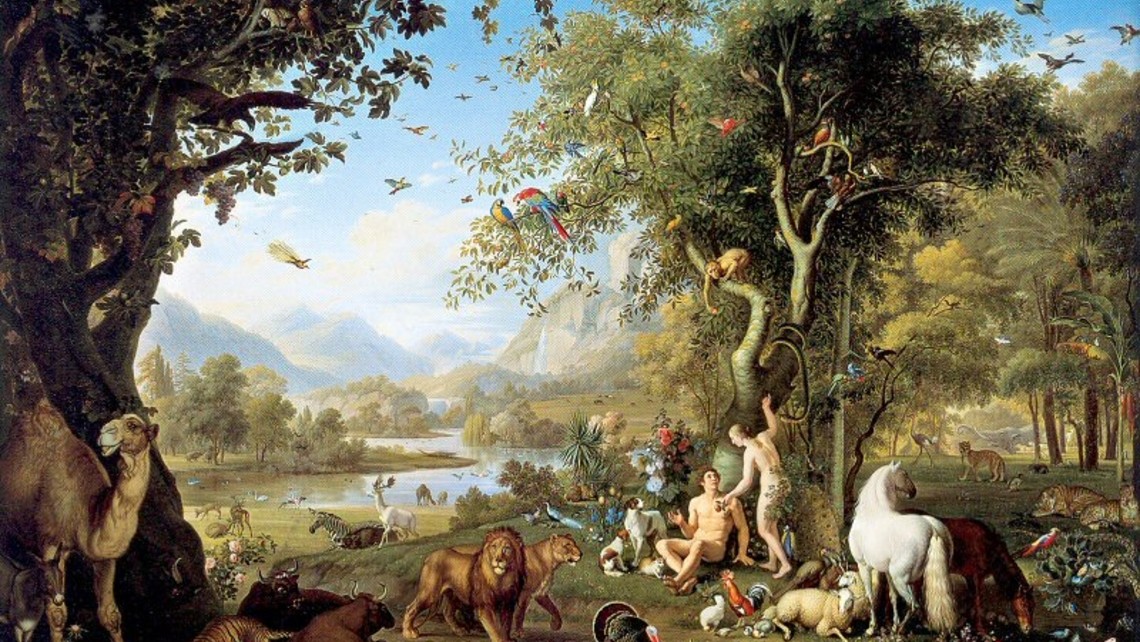
We can say that there is sex in the fabric of creation if we speak analogously. Human complementary sex differences reflect universal, cosmic principles of masculinity and femininity. Of course, with every analogy, there is a similarity and a difference. The difference is that we are not talking about complementary biological differences ordered to procreation when we discuss cosmic principles. But all complementary, biological differences ordered to procreation participate in the same origin as these cosmological principles. So what about the similarity?
Peter Kreeft has an excellent article on sexual symbolism in which he explains how all of creation is ordered according to the cosmic principles of masculinity and femininity (see also here). This is due to the fact that creation is an overflowing of Trinitarian love and this love is complementary. The created order has Trinitarian, complementary love as its most basic foundation. Hans Urs von Balthasar provides an explicit discussion of this in Vol 4 of his Theodrama. St. John Paul the Great's theology, though it does not directly address this theme, is quite compatible with Balthasar's on the point. Our discussion here will incorporate insights from these three great minds (St. John Paul II, Balthasar and Kreeft).
God is a Trinitarian Family of Three Persons Who are intimately united as all Three fully possess the one and only divine nature. These Persons are described by the Eternal Processions which John Paul characterizes as the total gift of Self of one divine Person to the Others. The Father’s total gift of Himself to the Son and the Son’s reciprocation of this gift are fruitful. This mutual Love is a Person—the Holy Spirit. Being the Source of everything that exists, this total self-giving establishes the framework for creation and so it is the interpretive key for understanding creation and most especially for understanding the human person who is created in the image of this Self-giving God. Von Balthasar teaches that the eternal Trinitarian Processions have analogical expression in human sex differences:
. . . the divine unity of action and consent . . . is expressed in the world in the duality of the sexes. In trinitarian terms, of course, the Father, who begets [the Son and] who is without origin, appears primarily as (super-) masculine; the Son, in consenting, appears initially as (super-) feminine, but in the act (together with the Father) of breathing forth the Spirit, he is (super-) masculine. As for the Spirit, he is (super-) feminine. There is even something (super-) feminine about the Father too, since . . . in the action of begetting and breathing forth he allows himself to be determined by the Persons who thus proceed from him; however, this does not affect his primacy in the order of the Trinity. The very fact of the Trinity forbids us to project any secular sexuality into the Godhead (as happens in many religions and in the Gnostic syzygia). It must be enough for us to regard the ever-new reciprocity of acting and consenting, which in turn is a form of activity and fruitfulness, as the transcendent origin of what we see realized in the world of creation: the form and actualization of love and its fruitfulness in sexuality (Theodrama: Theological Dramatic Theory, Vol V. The Last Act, trans. Graham Harrison [San Francisco: Ignatius Press, 1998], 91).
Balthasar anchors masculinity and femininity in different modes of act. One should understand the prefix “super-” in the sense that this divine archetype infinitely transcends our created understanding of masculinity and femininity, but nevertheless, it is the origin. For Balthasar, the primary male mode is an initiating act of love. The woman’s primary mode is an active, receptive act of love. The woman then secondarily returns this love and the man secondarily receives it. Human souls, which are the substantial forms of the body, have all that is necessary to human nature. They simply possess it differently. Every human soul thus must be exactly the same in terms of what it is (i.e. human nature) but it is unique in the way it is possessed by a human person. The person is the foundation of the sex difference in the soul. A specific human person is always and everywhere the sex (male or female) God knew him as from all eternity. One’s immutable sex in a basic manner, configures the person as this specific “who.”
This reading of Balthasar is quite consonant with John Paul II’s theology of the communio personarum-gift in his theology of the body catecheses, and which he succinctly summarizes in Mulieris dignitatem (MD): “When the author of the Letter to the Ephesians calls Christ “the Bridegroom” and the Church “the Bride”, he indirectly confirms through this analogy the truth about woman as bride. The Bridegroom is the one who loves. The Bride is loved: it is she who receives love, in order to love in return” (MD, 29).
This divine relation of love--an initiating love that we refer to as masculine and an actively receptive, reciprocating love which we call feminine, overflows into creation. God relates to His creation according to the masculine principle of love. Creation responds to God according to the feminine principle of love. But within creation itself, this same principle of masculine and feminine, complementary love is also found. Kreeft describes it this way:
...we must distinguish "male" from "masculine." Male and female are biological genders. Masculine and feminine, or yang and yin, are universal, cosmic principles, extending to all reality, including spirit.
All pre-modern civilizations knew this. English is almost the only language that does not have masculine and feminine nouns. So it is easy for us who speak English to believe that the ancients merely projected their own biological gender onto nature in calling heaven masculine and earth feminine, day masculine and night feminine, sun masculine and moon feminine, land masculine and sea feminine.
Yet, in the Hindu marriage ceremony, the bridegroom says to the bride, "I am heaven, you are earth." The bride replies, "I am earth, you are heaven." Not only is cosmic sexuality universal, its patterns are suspiciously consistent. Most cultures saw the sun, day, land, light, and sky as masculine; moon, night, sea, darkness, and earth as feminine. Is it not incredibly provincial and culturally arrogant for us to assume, without a shred of proof, that this universal and fairly consistent human inclination to find gender in creation is mere projection, myth, fantasy, and illusion rather than insight into a cosmic principle that is really there?
Once we look, we find abundant analogical evidence for it from the bottom of the cosmic hierarchy to the top, from the electromagnetic attraction between electrons and protons to the way angels relate to God. All of this has its origin in the circumincession of the divine Persons in the Trinity. Male and female are only the biological manifestation of the cosmic masculine and feminine principles. God is masculine in relation to everything created, from angels to prime matter. Everything in creation is feminine in relation to God.
Thus, we have a cosmic structure of complementary relations with binary terms. The first term, masculinity, is an initiating total-gift of self and the second, femininity, is an actively, receptive and reciprocating total self-gift. This is the cosmic structure of creation because it is the structure of Trinitarian love. The next installment will discuss human sex differences based upon this.




